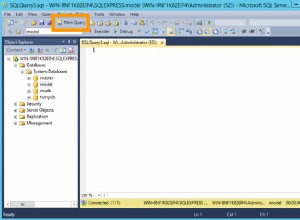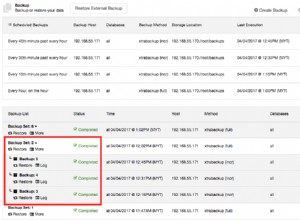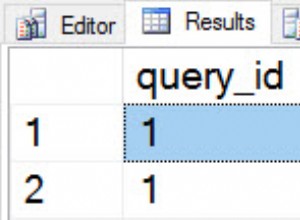package twcore.core.sql;
import java.io.File;
import java.sql.Connection;
import java.sql.PreparedStatement;
import java.sql.ResultSet;
import java.sql.SQLException;
import java.sql.Statement;
import java.util.HashMap;
import java.util.Iterator;
import twcore.core.BotSettings;
import twcore.core.SubspaceBot;
import twcore.core.events.;
import twcore.core.util.Tools;
/**
* Thread-based main class for the core's SQL database functionality.
* Initializes and manages SQL connection pools and queries, and runs
* background queries on a semi-regular basis.
* <p>
*
* Choosing a standard query vs. background/high-priority background query:
* <p>
* <b>Standard / foreground</b> - Runs exactly when needed. Does not wait in
* a queue to execute (unless connections are low). Does not require a unique
* identifier or special event handling. However, a standard query will
* pause the program thread until the results are returned. For large queries
* and bad connections this may result in long delays and unresponsiveness.
* <p>
* <b>Background</b> - Runs as a separate program thread. Waits in a
* queue and can be delayed by other queries waiting to execute. Requires the
* bot to catch an SQLResultEvent and use a unique identifier to refer to the
* query. As a separate thread, after the background query is run, the bot
* continues execution as normal, causing no delays. Ideal when multiple users
* may need to access large amounts of SQL data from the same bot at the same
* time without compromising responsiveness to the bot for others. However,
* their individual result sets may return more slowly than with a standard query.
* <p>
* <b>High-priority background</b> - Same as a background query, but added to the
* head of the queue. Combines the versatility of a background queue with the
* foreground's ability to return the result set almost instantly.
* <p>
* <b><u>IMPORTANT NOTE</b></u>
* For every query you MUST run BotAction's SQLClose(), or manually run the close()
* method on both the ResultSet and the Statement that created it. If you do not,
* memory leaks may occur!
*
* TODO:
* Setup Apache Commons DBCP to remove CommunicatonsExceptions:
* validationQuery="SELECT 1"
* testOnBorrow="true"
*/
public class SQLManager extends Thread {
BotSettings sqlcfg; // Reference to SQL config file
HashMap <String,SQLConnectionPool>pools; // Connection pool storage
HashMap <String,SQLBackgroundQueue>queues; // Background queue storage
boolean operational = true; // Status of SQL system
final static int THREAD_SLEEP_TIME = 30 * Tools.TimeInMillis.SECOND;
// Length of time for thread to
// sleep, in ms, after all
// background queries are done.
final static int STALE_TIME = 15 * Tools.TimeInMillis.MINUTE;
// Time in ms between stale conn checks.
private long nextStaleCheck = 0;
/**
* Initialize SQL functionality with the information given in the specified
* configuration file.
* @param configFile Properly formatted CFG file containing SQL system data
*/
public SQLManager( File configFile ) {
super("SQLManager");
pools = new HashMap<String,SQLConnectionPool>();
queues = new HashMap<String,SQLBackgroundQueue>();
sqlcfg = new BotSettings( configFile );
System.out.println( "=== SQL Initialization ===" );
try{
for( int i = 1; i <= sqlcfg.getInt( "ConnectionCount" ); i++ ){
String name = sqlcfg.getString( "Name" + i );
// TODO: Migrate to a DataSource object and pass that to SQLConnectionPool
// (com.mysql.jdbc.jdbc2.optional.MysqlDataSource)
String dburl = "jdbc:mysql://" + sqlcfg.getString( "Server" + i )
+ ":" + sqlcfg.getInt( "Port" + i ) + "/"
+ sqlcfg.getString( "Database" + i ) + "?user="
+ sqlcfg.getString( "Login" + i ) + "&password="
+ sqlcfg.getString( "Password" + i ) +
// Available properties (and info about them)
// http://dev.mysql.com/doc/refman/5.0/en/connector-j-reference-configuration-properties.html
"&allowMultiQueries=true" +
"&maxReconnects=2147483647" +
"&initialTimeout=1" +
"&logSlowQueries=false" +
"&interactiveClient=true" +
"&autoReconnect=true" + // Auto-Reconnect not recommended
"&autoReconnectForPools=true";
// TODO: Better pooling solutions now exist that can be configured to our needs.
SQLConnectionPool db = new SQLConnectionPool( name, dburl,
sqlcfg.getInt( "MinPoolSize" + i ),
sqlcfg.getInt( "MaxPoolSize" + i ),
sqlcfg.getInt( "WaitIfBusy" + i ),
sqlcfg.getString( "Driver" + i )
);
pools.put( name, db );
queues.put( name, new SQLBackgroundQueue() );
}
Tools.printLog( "SQL Connection Pools initialized successfully." );
for( Iterator<SQLConnectionPool> i = pools.values().iterator(); i.hasNext(); ){
Tools.printLog( i.next().toString() );
}
} catch( SQLException e ){
Tools.printLog( "Failed to load SQL Connection Pools. Driver missing?" );
operational = false;
Tools.printLog( e.getMessage() );
}
if( operational ){
start();
Tools.printLog( "SQL Background Queues initialized." );
} else {
Tools.printLog( "SQL Background Queues NOT initialized." );
}
System.out.println();
nextStaleCheck = System.currentTimeMillis() + STALE_TIME;
}
/**
* Adds a regular background query to the end of the queue. If there are no
* queued queries ahead of it, the background query will be executed nearly
* as quickly as a regularly executed query, but without delaying the bot's
* thread to retrieve the result set. The query is instead run in a new
* thread and returned to the bot via an SQLResultEvent, and is identified by
* a unique key (<CODE>identifier</CODE>).
* @param connName Name of the connection as defined in sql.cfg
* @param identifier The unique identifier for this query
* @param query A properly-formed SQL query
* @param bot The bot requesting the query (if unsure, use <b>this</b>)
*/
public void queryBackground( String connName, String identifier,
String query, SubspaceBot bot ){
if( !operational ){
Tools.printLog( "Unable to process query: " + query );
} else {
if( !pools.containsKey( connName )) {
Tools.printLog( "Invalid connection name supplied: '" + connName + "'" );
return;
}
SQLBackgroundQueue queue = queues.get( connName );
queue.addQuery( new SQLResultEvent( query, identifier, bot ));
interrupt();
}
}
/**
* Adds a background query to the front of the queue. A high-priority
* background query will be executed nearly as quickly as a regularly
* executed query, but without delaying the bot's thread to retrieve the
* results. The query is instead run in a new thread and returned to the bot
* via an SQLResultEvent, and is identified by a unique key (<CODE>identifier</CODE>).
* @param connName Name of the connection as defined in sql.cfg
* @param identifier The unique identifier for this query
* @param query A properly-formed SQL query
* @param bot The bot requesting the query (if unsure, use <b>this</b>)
*/
public void queryBackgroundHighPriority( String connName, String identifier,
String query, SubspaceBot bot ){
if( !operational ){
Tools.printLog( "Unable to process background high priority query: " + query );
} else {
if( !pools.containsKey( connName )) {
Tools.printLog( "Invalid connection name supplied: '" + connName + "'" );
return;
}
SQLBackgroundQueue queue = queues.get( connName );
queue.addHighPriority( new SQLResultEvent( query, identifier, bot ));
interrupt();
}
}
/**
* Runs a regular SQL query using the specified database connection. Your
* bot's thread will not continue while the query is in effect. Use a
* background query if you wish for the thread to continue while the query
* is executed.
* @param connectionName Name of the connection as defined in sql.cfg
* @param query A properly-formed SQL query
* @return The result set of the query (MAY be null)
* @throws SQLException
*/
public ResultSet query( String connectionName, String query ) throws SQLException {
if( !operational ){
Tools.printLog( "Unable to process query: " + query );
return null;
} else {
if( !pools.containsKey( connectionName )) {
Tools.printLog( "Invalid connection name supplied: '" + connectionName + "'");
return null;
}
return pools.get( connectionName ).query( query );
}
}
/**
* Creates a PreparedStatement.
* Gets a Connection from the specified SQLConnectionPool (specified by the connectionName)
* and creates a PreparedStatement object using the specified query.
* Note that this sets the connection to "busy" in the SQLConnectionPool so it isn't used by other processes.
*
* You need to free it when the bot doesn't use the PreparedStatement anymore or this will be a Connection-leak !!
*
* @param connectionName Name of the connection as defined in sql.cfg
* @param uniqueID A unique string that is used for re-using (busy) Connections in the connection pool. This is only used for PreparedStatements as their Connection is locked when a bot creates a PreparedStatement.
* @param sqlstatement The (dynamic) SQL INSERT/UPDATE statement that will be pre-parsed for the PreparedStatement
* @param retrieveAutoGeneratedKeys whether auto-generated keys should be returned
* @return PreparedStatement object or null if there was an error
*/
public PreparedStatement createPreparedStatement(String connectionName, String uniqueID, String sqlstatement, boolean retrieveAutoGeneratedKeys) {
if( !operational ) {
Tools.printLog( "Unable to create PreparedStatement object; SQL System is not operational");
return null;
} else {
if(!pools.containsKey( connectionName ))
return null;
else {
try {
// Have we hit the maximum number of allowed connections in the pool?
if(pools.get(connectionName).isAvailable() || pools.get(connectionName).totalConnections() < pools.get(connectionName).getMaxConnections()) {
Connection conn = pools.get( connectionName ).getConnection(uniqueID);
if(retrieveAutoGeneratedKeys)
return conn.prepareStatement(sqlstatement, Statement.RETURN_GENERATED_KEYS);
else
return conn.prepareStatement(sqlstatement, Statement.NO_GENERATED_KEYS);
} else {
Tools.printLog("No more connections available in pool '"+connectionName+"' to create PreparedStatement!");
return null;
}
} catch(SQLException sqle) {
Tools.printLog("SQLException encountered while trying to create a PreparedStatement from a Connection from '"+connectionName+"':"+sqle.getMessage());
return null;
}
}
}
}
/**
* Frees specified Connection for specified connectionpool using specified unique ID.
* This should be used when closing a PreparedState\ment as it locks a connection on creation.
*
* @param connectionName Name of the connection as defined in sql.cfg
* @param uniqueID The unique ID used to create the Prepared Statement
* @param conn Connection used when creating a PreparedStatement
*/
public void freeConnection(String connectionName, String uniqueID, Connection conn) {
if( !operational ) {
Tools.printLog( "Unable to free Connection; SQL System is not operational");
} else {
if(pools.containsKey( connectionName )) {
pools.get( connectionName ).free(uniqueID, conn);
}
}
}
/**
* @return True if the SQL system is operational
*/
public boolean isOperational(){
return operational;
}
/**
* Prints to the log file the status of all connection pools.
*/
public void printStatusToLog(){
if( !operational ){
Tools.printLog( "SQL Connection Not Operational" );
} else {
Tools.spamLog( getPoolStatus() );
}
}
/**
* Gets status of all connection pools.
* @return String array containing status of each individual connection pool.
*/
public String[] getPoolStatus() {
String[] status = new String[pools.size()];
Iterator<SQLConnectionPool> i = pools.values().iterator();
for(int j = 0; j<status.length; j++)
status[j] = i.next().toString();
return status;
}
/**
* Checks the background queue for queries waiting to be run, and dispatches
* them each to a separate SQLWorker thread. After the result is received,
* it's then returned as an SQLResultEvent to the bot that made the query.
* The SQLManager thread will sleep for a defined amount of time, but will
* interrupt/return when a background query requires processing.
*
* Also runs a check for stales on each pool of connections periodically.
*/
public void run() {
boolean checkForStales;
while( true ){
// Run background queries
Iterator<String> i = queues.keySet().iterator();
while( i.hasNext() ){
String name = i.next();
SQLBackgroundQueue queue = queues.get( name );
SQLConnectionPool pool = pools.get( name );
while( !queue.isEmpty() && !pool.reachedMaxBackground() ){
SQLResultEvent event = queue.getNextInLine();
try {
new SQLWorker( pool, event, this );
} catch (Exception e) {
Tools.printLog("Uncaught exception encountered running background query.");
Tools.printStackTrace(e);
}
}
}
// Perform stale check
checkForStales = (nextStaleCheck < System.currentTimeMillis());
i = pools.keySet().iterator();
while( i.hasNext() ) {
String name = i.next();
SQLConnectionPool pool = pools.get( name );
if( checkForStales )
pool.updateStaleConnections();
}
if( checkForStales )
nextStaleCheck = System.currentTimeMillis() + STALE_TIME;
try{
Thread.sleep( THREAD_SLEEP_TIME );
} catch( InterruptedException e ){}
}
}
}
package twcore.core.sql;
import java.sql.ResultSet;
import java.sql.SQLException;
import twcore.core.events.SQLResultEvent;
import twcore.core.util.Tools;
/**
* Runs a background SQL query given a connection pool to use and an undelivered
* SQLResultEvent object to place the results into. By handling in a separate
* thread, it frees the bot process of having to wait on a query.
*/
public class SQLWorker implements Runnable {
private SQLResultEvent m_event; // Event to hand the ResultSet to
private SQLConnectionPool m_pool; // Connection pool to run query on
private SQLManager m_manager; // For interrupting any waits
/**
* Creates a new SQLWorker and begins a background query, given a connection
* pool to use for the query, an event to place the result set returned by
* the query into, and an SQLManager to wake up/interrupt when the process
* has finished (if it is currently sleeping).
* @param pool Connection pool to use to run the query
* @param event Event that will afterward contain the returned ResultSet
* @param manager Waiting object to interrupt when finished
*/
public SQLWorker( SQLConnectionPool pool, SQLResultEvent event, SQLManager manager ) {
m_pool = pool;
m_manager = manager;
Thread t = new Thread( this, "SQLWorker" );
m_event = event;
m_pool.incrementBackgroundCount();
t.start();
}
/**
* Runs the SQL query found in the SQLResultEvent the SQLWorker was instantiated
* with. Sets the returned ResultSet inside the event, which in turn will fire
* the event in the bot so as to be handled and fetched by unique key. After
* this is done, the background queue count of the connection pool used is
* reduced by one, and the SQLManager that called the worker is interrupted
* back into consciousness, if it is currently asleep.
*/
public void run() {
try{
ResultSet set = m_pool.query( m_event.getQuery() );
m_event.setResultSet( set );
m_pool.decrementBackgroundCount();
m_manager.interrupt();
} catch( SQLException e ){
Tools.printLog("SQLException encountered while running background query in SQLWorker.");
Tools.printStackTrace( e );
}
}
}
Có nhiều tệp hơn nhưng tôi không thể dán chúng vì tôi đã đạt đến giới hạn trong câu hỏi này. Tôi sẽ chỉ dẫn bạn bằng URL
http://www.twcore.org/browser/trunk / twcore / src / twcore / core / sql




